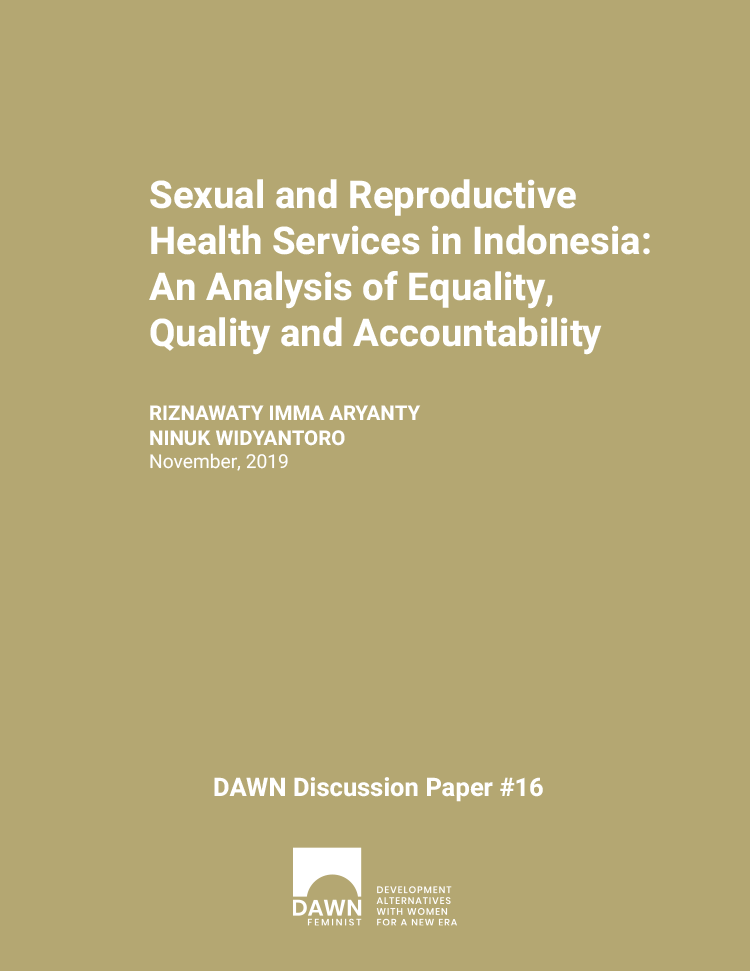Introduction
It has been nearly 25 years since the United Nations International Conference on Population and Development (ICPD) with its Programme of Action (PoA) that was agreed by consensus in Cairo in 1994. ICPD set key goals to be achieved by 2015, including reduction of infant, child and maternal mortality; provision of universal access to education, particularly for girls; and provision of universal access to a full range of reproductive health services, including family planning (UNFPA, 1994). Following the ICPD in 1994, there have been advances in various aspects of sexual and reproductive health services in Indonesia.
In the four years after Cairo, Indonesia went through significant political changes. The fall of the New Order in 1998 (ending Suharto’s 30-year regime) brought a dramatic transformation to Indonesian society. Two years later, in 2000, Indonesia implemented a decentralisation policy and the law on local government was enacted to establish financial balance between central and local governments. Decentralization added more complexity to the institutional arrangements of program deliveries and brought about a dramatic change in the administration arrangement in districts, whereby authority for planning and development was transferred to district government. Decentralisation to district level gives significant authority to district administrations in program funding and implementation, while at the same time districts have limited capacity and experience in managing programs.
The fall of the New Order in 1998 also witnessed an increase in the influence of conservative Islamic values in the community (Rinaldo 2008). A growing trend to root ideas for change in religious discourse and making Islam a more central aspect of life in Indonesia was observed. This in many ways posed new challenges to sensitive issues such as promotion of a sexual and reproductive health program. The rise of conservatism was accompanied by the emergence of symbols representing Islamic piety, appearing in the form of increasing use of veiling among Muslim women and the practice of polygamy that usually involves Siri marriage. This form of informal marriage is not usually registered, which increases vulnerability of both women and children in this situation. A rise of conservative forces has also led to a call for “strengthening of family values” to make the country more “civilized”. One of these groups has requested a judicial review to outlaw any consensual sexual relationship outside marriage, including same- sex relationships. To what extent conservative groups influence decisions on the number of children and, therefore, family planning is currently not documented.
The two main Sexual and Reproductive Health and Rights (SRHR) programs implemented by the government in Indonesia are family planning and maternal health. The maternal health program was introduced during the pre-independence period (early 1940s) as a key community health program, at a time in Indonesia when high maternal deaths were identified as a pressing community health problem. After independence in 1945, maternal and child health got specia attention, with the establishment of centres for Mother-and-Child Welfare (Balai Kesejahteraan Ibu dan Anak, BKIA) at district level from 1952. These centres were then merged with polyclinics at community health centres and became the health centres (Puskesmas), the precursors of the primary health care system in Indonesia (Cholil, Iskandar & Sciortino, 1998). In successive decades there was a rapid expansion of health care facilities that significantly increased access to care.
The family planning program was introduced later, with some reservation at first (Hull, 2007). In the late 1950s a group of doctors established Perkumpulan Keluarga Berencana Indonesia/PKBI (Indonesian affiliation of the International Planned Parenthood Federation/IPPF). The family planning program was later promoted mainly as a response to internal and external concerns of rapid population growth, especially in major cities (Hull, 2006). The National Institute for Family Planning (Lembaga Keluarga Berencana Nasional/LKBN) was established in 1968 and then transformed into the National Family Planning Coordinating Board (Badan Koordinasi Keluarga Berencana Nasional/BKKBN) in 1970. The family planning program has since expanded, increasing contraceptive use from 0 to more than 60 per cent within four decades. The program is internationally renowned for rapidly expanding access to and use of modern contraceptives, and BKKBN got credit for much of this success.
A major recent advance in provision of health services in Indonesia is the enactment of the National Health Insurance Scheme (Jaminan Kesehatan Nasional/JKN6) since 2014. The JKN aims to achieve universal health coverage for all by the end of 2019. At the end of the first- year implementation of JKN, 133.4 million people were covered. By mid-2019, 222 million people were covered by JKN, equal to 84.1 per cent of the population. With JKN, the cost for health services, including SRHR such as family planning services, antenatal care, delivery, post-partum and treatment of sexually transmitted diseases, can be obtained free of charge or at a minimal cost. In the other words, implementation of JKN offers a great opportunity to address the continuing problem of high maternal mortality as it removes the user fee. Financial constraints are dominant factors causing maternal deaths in Indonesia (D’ambruso, Byass, & Qomariyah, 2010).
This case study aims to describe the progress in achieving ICPD PoA goals in Indonesia. It describes the law and policy context of SRHR development in Indonesia and progress to date, emphasising the two main components of SRHR, maternal health and family planning programs. Data and information were gathered from the latest survey reports, focused group discussions and interviews with key informants. The case study applies a framework of quality, equality and accountability to assess laws, policies and programs towards respecting, protecting and fulfilling the human rights of the most disadvantaged women (Sen, 2013).

